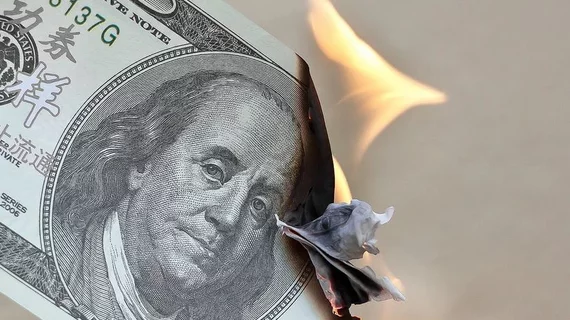Artificial intelligence is going to lower both the costs of supplying radiology services and the payments made for them. However, if practices make the right moves around technology, the business outcome will help lift the specialty’s value and expand its markets.
The case was made Dec. 1 at RSNA 2019 in Chicago by Gregory Nicola, MD, vice president of Hackensack Radiology Group in New Jersey and chair of the American College of Radiology’s committee on MACRA, the Medicare Access and CHIP Reauthorization Act.
Speaking on the financial outlook for large private rad practices, Nicola zeroed in on AI as a top technology with which practices now need to reckon.
He pointed to Gutenberg’s printing press in the 1400s as an early example of a disruptive technological innovation that quite quickly reordered an entire economy.
Before Gutenberg, scribes labored mightily to turn out 40 or so pages per day.
“You can imagine the drop in quality by the time a scribe got to the 40th page” after writing by hand all day, Nicola commented.
The earliest iteration of the Gutenberg press allowed one operator to produce 400 pages per day, he pointed out. By the middle of the Renaissance, the daily yield was up to 4,000 pages of quality product.
The result was an explosion of both books and knowledge.
“This had serious impact,” Nicola said. “And it didn’t necessarily reduce the cost or affect what the operator earned because the productivity was so much higher and created so much more demand.”
AI as radiology market expander?
To extend the thought experiment to radiology, Nicola stuck with the two basic components of RVUs—technical (image acquisition) and professional (image interpretation).
“You can imagine machine learning applications that reduce the amount of time to perform an MRI to, let’s say, half,” Nicola said. “What does that do to the RVUs? It will reduce them. Eventually that will trickle up through the fee schedule and will reduce the amount of RVUs you’re paid for that imaging exam.”
Case in point: a self-localizing, self-protocoling AI algorithm that allows a technologist to run three machines. This would reduce a practice’s use of human resources and medical supplies while also reducing its RVUs.
“And you can do the same thing on the professional side,” Nicola said. “You can get through a case quicker because you’re not staring for pulmonary nodules the whole time. This reduces the work intensity in that you have less liability for missing something, because you have a machine algorithm backing you up.”
The bottom line, Nicola underscored, is the certainty of downward pressure on radiology’s RVUs.
“It’s just inevitable,” he said. “That’s what technology does, and it does this in every case. It makes you more cost-efficient and higher value.”
AI technology “will lower our costs and it will lower our payments, but our quality should go up,” Nicola continued. “Hopefully these algorithms improve patient care. Right? That’s the promise here.”
Innovate or depreciate
If radiology follows along the trajectory exemplified by Western economies after Gutenberg’s printing press, the specialty should enjoy an explosion in the use of imaging.
At the same time, Nicola said, such a development is by no means a sure thing.
“This is the big black-box moment that we all have to think about,” he said. “Are there more patients for us to image? That’s what we have to think about as a specialty.”
Radiology needs to find “more reasons to safely screen people for cancer,” Nicola concluded. “We need to find more diseases to screen for with imaging. We need to control our false positives. We need to control our risk profile for contrast and radiation.
“And then maybe we’ll have more patients to expand our practice. Without an expansion of patients to image, we will have downward pressure on our workforce, for sure.”
Nicola closed his talk with a paraphrase of Terry Jones, the lead force behind Travelocity, Kayak and other successful startups.
“If we don’t start investing in innovation, the [gathering] disruption will take all that’s left,” Nicola said. “This is something the specialty has to think about. Every practice should be investing something in how you can innovate with your local market.”

